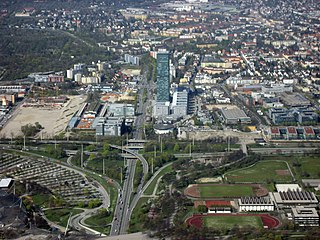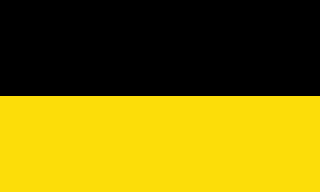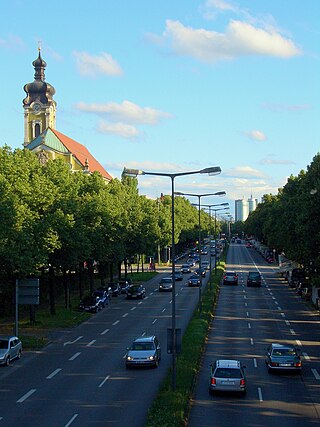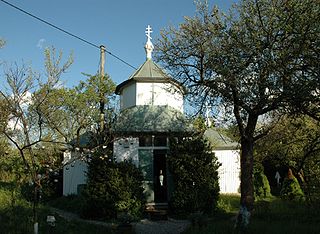
Neuhausen-Nymphenburg is a borough of Munich, the capital of the German state of Bavaria. It was created from the merger of the former boroughs of Neuhausen (Central Bavarian: Neihausn) and Nymphenburg in 1992.

Neuhausen-Nymphenburg is a borough of Munich, the capital of the German state of Bavaria. It was created from the merger of the former boroughs of Neuhausen (Central Bavarian: Neihausn) and Nymphenburg in 1992.


Nymphenburg borders Obermenzing in the north-west, Pasing in the south-west, Moosach in the north and Neuhausen in the south-east.
The borough 09 ranges from the Mars-field at the inner edge of town to the Nymphenburg Palace in the west and extends from the south part of the Olympic Park (including the Tollwood Summer festival area and the East-West Peace Church) over the villa colony in Gern to the railway tracks.
Neuhausen is a very quiet and calm residential area. It counts as one of the most exclusive and expensive boroughs in Munich.
Typical of the borough is its mix of different urban areas. Around the end of the 19th Century a prestigious residential neighborhood was built in the palace's vicinity, where numerous examples of late nineteenth century architecture, like the villa colonies Neuwittelsbach and Gern can be found.
In 1890 the borough Neuhausen was unincorporated, which had already been a prosperous district. It was dominated by residential and office houses in a closed, dense block-building style. Along the Arnulfroad and its side streets, these are often cooperative apartment buildings such as the partly under preservation attempt-settlement of the Bavarian Post and Telegraph Association and the village of Neuhausen. In the north of the Rotkreuzplatz there are more villas and town houses of the early days.
In the south along the railway tracks there are partly dominating large-scale commercial used buildings. Center and urban hub of the neighborhood of the Rotkreuzplatz. Some well-preserved buildings from the founder and inter-war period with the rich variety of green spaces give Neuhausen a high quality of living. While the old quarters in the vicinity of Nymphenburgerstreet and Blutenburgstreet are home to upper middle class for some time, the sometimes less sumptuously executed turn of the century buildings offer in the vicinity of Schulstreet and Donnersbergerstreet housing for various population groups. But has also kept the so-called gentrification catchment by road trains and remodeled buildings were renovated. In addition, there were numerous conversions take place in condominiums and shops were once easy to architectural firms, alternative shops, bars and restaurants. For this reason, the City Council in 2006 extended the statute for preservation of this neighborhood, to counteract the displacement of ancestral inhabitants.
On 1 January 1891 the independent municipality Nymphenburg was incorporated to the city of Munich.
It is named after the Nymphenburg Palace, former summer residence of the Bavarian kings. Today the castle along with the Nymphenburg Palace Park is one of the most popular sights of Munich.
The in 1747 by Elector Max III. Joseph founded Nymphenburg Porcelain Manufactory, the Royal Stables Museum of Nymphenburg and the Museum of Man and Nature is located next to the palace. On the Nymphenburg Palace Park also borders the Botanical Garden, which entrance is near the Bavarian State Office of Weights and Measures. The Hirschgarten and the Olympic Park complement the diverse range of parks and recreational areas. Because the borough is connected by the motorway A8 and the ring road it is charged by high traffic volumes. Neuhausen-Nymphenburg has about 90,000 inhabitants, according to Ramersdorf-Perlach the second highest population of the boroughs of Munich. In the north of Neuhausen, between the borough is Gern and Moosach-Nederling, in the northeastern the borough of Ebenau.
The jobs of the district are in addition to trade and service sector largely in the public sector. Apart from the branch of Deutsche Bahn, the Bundeswehr's administrative center, the Bavarian State Criminal Police Office, and numerous hospitals, such as the Red Cross Hospital, the German Heart Center, the Brothers of Mercy Hospital and the Third Order Hospital there are also major social institutions in the borough.
The proportion of foreigners Nymphenburg is low, in Neuhausen it is average. Regarding the age distribution Neuhausen is the younger of the two districts.
(As of each 31 December, residents whose main residence)
| year | residents | foreigners | area (ha) | res./ha | source and further details |
|---|---|---|---|---|---|
| 2000 | 81.968 | 17.923 (21,9%) | 1,291,86 | 63 | Statistisches Taschenbuch München 2001. pdf-Download |
| 2001 | 82.235 | 17.972 (21,9%) | 1.291,86 | 64 | Statistisches Taschenbuch München 2002. pdf-Download |
| 2002 | 81.947 | 17.795 (21,7%) | 1.291,86 | 63 | Statistisches Taschenbuch München 2003. pdf-Download |
| 2003 | 81.661 | 17.703 (21,7%) | 1.291,84 | 63 | Statistisches Taschenbuch München 2004. pdf-Download |
| 2004 | 81.921 | 18.041 (22,0%) | 1.291,61 | 64 | Statistisches Taschenbuch München 2005. pdf-Download |
| 2005 | 82.156 | 17.890 (21,8%) | 1.291,45 | 64 | Statistisches Taschenbuch München 2006. pdf-Download |
| 2006 | 84.604 | 18.016 (21,3%) | 1.289,08 | 66 | Statistisches Taschenbuch München 2007. pdf-Download |
| 2007 | 85.964 | 18.118 (21,1%) | 1.287,95 | 67 | Statistisches Taschenbuch München 2008. pdf-Download |
| 2008 | 87.043 | 18.836 (21,2%) | 1.293,31 | 67 | Statistisches Taschenbuch München 2009. pdf-Download |


In Munich each borough has a Borough Committee (Bezirksausschuss BA). The Borough Committees are elected by local citizens in municipal elections. The Borough Committee consists 39 members. The election of the Borough Committee of 2 March 2008 yielded the following results:
Chairman of the BA is Ingeborg Staudenmeyer (SPD). The Vice-Chairmen are Roland Zintl (Greens) and Immoi Scheibel (CSU). The Greens and the ÖDP provide a common fraction.
The municipality is represented in the City Council by Oliver Belik (SPD) and Councilwoman Elizabeth Schmucker (CSU). [1]
According to legend, Neuhausen was christianised by Blessed Winthir in the 8th century.

Munich is the capital and most populous city of the Free State of Bavaria. With a population of 1,589,706 inhabitants as of 29 February 2024, it is the third-largest city in Germany, after Berlin and Hamburg, and thus the largest which does not constitute its own state, as well as the 11th-largest city in the European Union. The city's metropolitan region is home to about 6.2 million people and the third biggest metropolitan region by GDP in the European Union.

The Nymphenburg Palace is a Baroque palace situated in Munich's western district Neuhausen-Nymphenburg, in Bavaria, southern Germany. The Nymphenburg served as the main summer residence for the former rulers of Bavaria of the House of Wittelsbach. Combined with the adjacent Nymphenburg Palace Park it constitutes one of the premier royal palaces of Europe. Its frontal width of 632 m (2,073 ft) even surpasses Versailles.

The Munich S-Bahn is an electric rail transit system in Munich, Germany. "S-Bahn" is the German abbreviation for Stadtschnellbahn, and the Munich S-Bahn exhibits characteristics of both rapid transit and commuter rail systems.
The Munich U-Bahn is an electric rail rapid transit network in Munich, Germany. The system began operation in 1971, and is operated by the municipally owned Münchner Verkehrsgesellschaft. The network is integrated into the Münchner Verkehrs- und Tarifverbund and interconnected with the Munich S-Bahn. The U-Bahn currently comprises eight lines, serving 96 stations, and encompassing 103.1 kilometres (64.1 mi) of routes.

Gröbenzell is a municipality and suburb to Munich in the district Fürstenfeldbruck, in Bavaria, Germany. It was founded in 1952, and has a population of 19,202. Gröbenzell is often called a garden city, which is also illustrated by the two flowers in the coat of arms.

Fürstenried Palace is a Baroque maison de plaisance and hunting lodge in Munich, Germany. It was built from 1715 to 1717 for Elector Maximilian II Emanuel. Today the palace serves as spiritual house for archdiocese and as pastoral center.

The Nymphenburg Porcelain Manufactory is located at the Nördliches Schloßrondell in one of the Cavalier Houses in front of the Nymphenburg Palace in Munich, Germany, and since its establishment in 1747 has produced porcelain of high quality. It is one of the last porcelain producers in the world where every single part is made entirely by hand.

Milbertshofen, Am Riesenfeld and Am Hart are three boroughs situated in the north of Munich in Germany. Jointly, they form the city district 11 Milbertshofen-Am Hart. As of December 2016, the three boroughs had 76,255 inhabitants.

Glonn is a market town in the Ebersberg district in Upper Bavaria, Germany, about 30 km (19 mi) southeast of Munich.

Aubing-Lochhausen-Langwied is the 22nd borough of the German city of Munich. The districts Aubing, Lochhausen and Langwied were incorporated together in 1942, thus forming the largest borough of the city at 3,400 hectares, yet having the lowest density of population with 37,352 residents as of 2002. This large borough still accommodates many vast agricultural and forest areas that together with the Aubinger Lohe and the Langwieder lake district, fulfill the balance of nature in the area and offer recreational facilities to all of western Munich.

The Dachauer Straße is the longest street in Munich with a length of 11.2 km and it received its name since it is the connecting road to Dachau Palace. In the north of Munich, it is part of the Bundesstraße 304.

Moosach is the 10th northwestern district of Munich, Bavaria, Germany. It is sectioned in the urban districts Hartmannshofen, Pressestadt and Borstei.

The Donnersbergerstraße is a street in the Munich district Neuhausen, in the city district of Neuhausen-Nymphenburg. It connects the Rotkreuzplatz with the Arnulfstraße in the north-south direction. It is named after the Privy Councilor and Supreme Chancellor of the Bavarian elector Maximilian I, Joachim Freiherr von Donnersberg (1561–1650), who came from the Munich patrician family, Donnersberger.

The following outline is provided as an overview of and topical guide to Munich:

The Arnulfstraße is a 3.8 km long urban street in Munich. It leads from the Bahnhofplatz in the Ludwigsvorstadt through the Maxvorstadt west to Romanplatz in Neuhausen. Over the Hackerbrücke, there is a connection to the Landsberger Straße, which runs parallel to the south of the railway tracks. Until 1983, the tram line 3 drove through the Arnulfstraße. It was initially diverted in the course of the Munich S-Bahn construction and then shut down. In 1996, the tram service was reopened on the Arnulfstraße with the line number 17.

Neuhauser Straße is part of the first and largest pedestrian zone in Munich's Old Town. Here, many retail shops and restaurants are to be found.

The Landshuter Allee is an avenue in Munich and through most of its course it is part of the Mittlerer Ring, the Bundesstraße 2 R. It joins Donnersbergerbrücke at Arnulfstraße in the Neuhausen district and runs from Dachauer Straße west of the Olympiapark to Moosacher Straße west of the Olympic village in the Moosach district. The B 2R leaves the intersection-free avenue at the Landshuter Allee and continues on the Georg-Brauchle-Ring. The Landshuter Allee now functions as the B 304 and connects the Mittlerer Ring with the northern tangent of the Outer Ring, which is only partially complete. The large width of the Landshuter Allee of 54 metres between the houses is striking. It crosses the Nymphenburg-Biedersteiner Kanal.

The Nymphenburg Palace Park ranks among the finest and most important examples of garden design in Germany. In combination with the palace buildings, the Grand circle entrance structures and the expansive park landscape form the ensemble of the Nymphenburg Summer Residence of Bavarian dukes and kings, located in the modern Munich Neuhausen-Nymphenburg borough. The site is a Listed Monument, a Protected Landscape and to a great extent a Natura2000 area.

Leonrodplatz is a square in the Munich district of Neuhausen. It was named in 1927 after the former Bavarian Minister of Justice Leopold von Leonrod.

The East-West Peace Church, also known as the Church of Father Timofej, was a chapel in the Olympiapark in Munich.